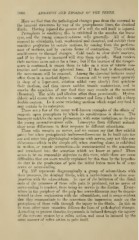Page 998 - My FlipBook
P. 998
1008 ABRASION AND EROSION OF THE TEETH.
Here we find that the pathological changes pass from the external to
the internal structures by M'ay of the protoplasmic lines, the dentinal
fibrils. Having injured the process of a cell, the cell itself is injured.
Protoplasm is sensitive ; this is exhibited in the amoeba, the leuco-
cyte, and the young connective-tissue cells generally. All of these
respond to stimulants, both mechanical and chemical, and exhibit their
sensitive properties by certain motions, by ceasing from the perform-
ance of motions, and by various forms of contraction. They exhibit
sensitiveness to thermal changes. Cold tends to slow their motions,
and if its degree is increased will stop them entirely. Heat renders
their motions more active for a time ; but if the increase of the temper-
ature is continued, it causes them to take on a state of tetanic con-
traction and assume the spherical form. If the heat is discontinued,
the movements will be resumed. Among the chemical irritants many
affect them in a marked degree. Common salt in very small quantity
(a drop of a 1-per-cent. solution added very slowly) first quickens
their motions, and then causes sudden tetanic contractions, and in
amoeba the expulsion of any food they may contain at the moment
(Brunton). The acids and alkalies affect them prominently. Hydro-
chloric acid causes the amoeba to contract and form a ball with a sharp
double contour. In it occur twitching motions which expel any food it
may contain in its substance.
These are a few of the many well-known examples of the effects of
reagents upon protoplasm by wdiich its sensitiveness is shown. The
leucocyte exhibits the same phenomena, with some variations, as do also
the young connective-tissue cells. Leucocytes from different animals
show some differences in their response to different stimulants.
These cells contain no nerves, and we cannot say that they exhibit
pain ; but when protoplasmic bodies—cells—come to be built into tis-
sue and enter into physiological relations with nerves, may not this sen-
sitiveness—which in the simple cell, when standing alone, is exhibited
in motion, or tetanic contraction—be communicated to the sensoriura
and translated into the sensation which we know as pain? There
seems to be no reasonable objection to this view. Mobile there are some
difficulties that are more readily explained by this than by the hypothe-
sis that in the production of pain the initial lesion must be of soma
nerve or nerve-ending.
Fig. 537 represents diagramatically a group of odontoblasts w'ith
their processes, the dentinal fibrils, with a nerve-branch in close con-
junction with the odontoblasts. In case of the irritation of the distal
ends of the processes of these cells pain is produced, yet no nerve or
nerve-ending is touched, there being no nerves in the dentine. Every-
where in the periphery of the pulp fine nerve-filaments may be demon-
strated in close conjunction with the odontoblasts, and it seems evident
that they communicate to the sensorium the impression made on the
protoplasm of these cells through the injury to the fibrils. In this as
in most other cases sensation follows the lines of pathological changes.
According to present theories, hypersemia is induced through the agency
of the nervous system by a reflex action, and must be induced by the
same manner of reflex action as pain itself.


